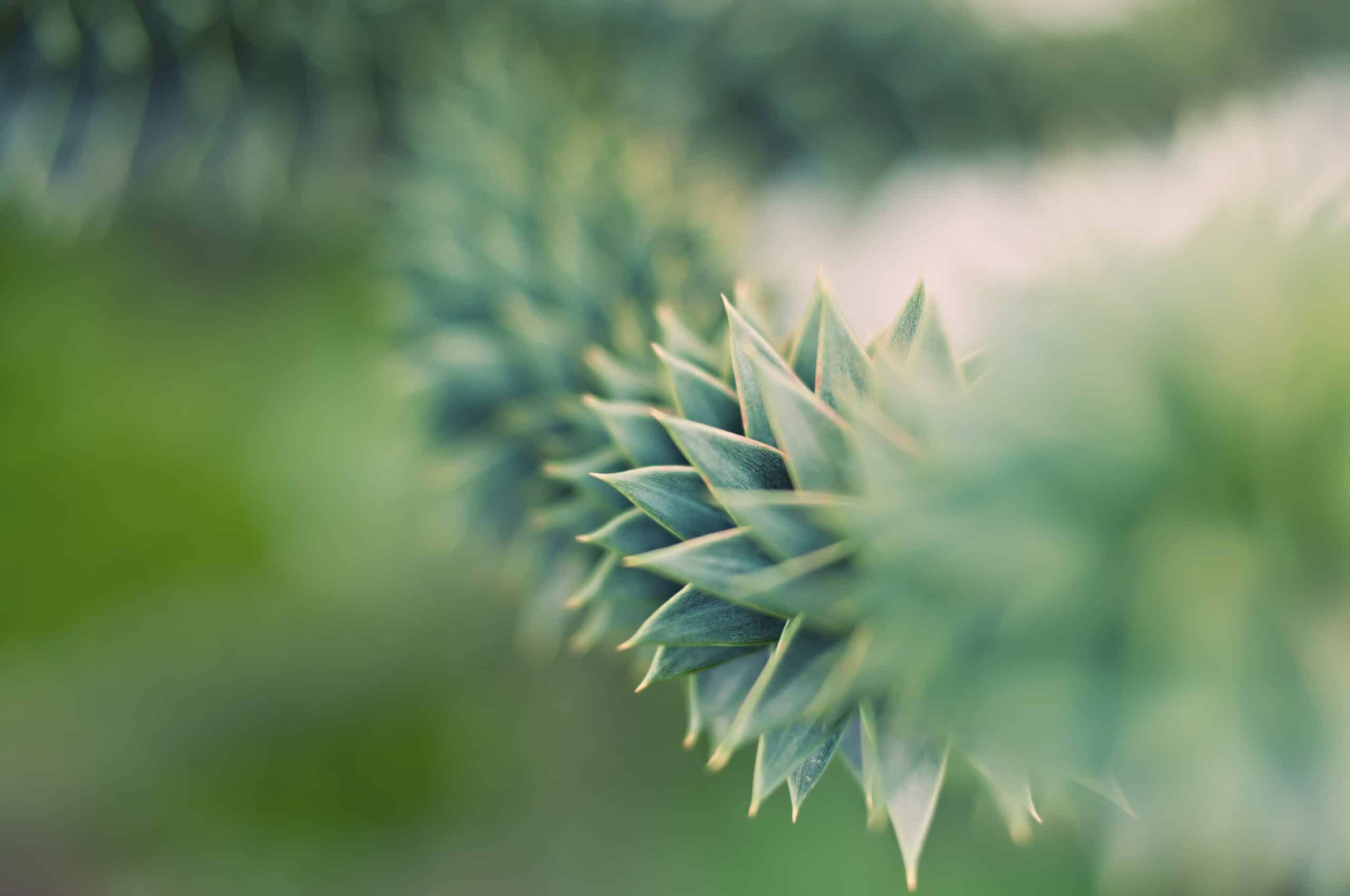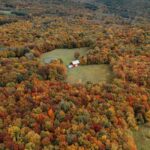Many people may not be familiar with the unique and fascinating monkey puzzle tree. However, those who are aware of this majestic evergreen tree will know that it is a highly desirable addition to any garden or outdoor space. In spite of its exotic appearance and daunting size, caring for a monkey puzzle tree is actually much easier than one might expect. Indeed, these trees require relatively little maintenance in comparison to other types of trees and shrubs, making them ideal for even novice gardeners.
The monkey puzzle tree (Araucaria araucana) hails from the cool temperate rainforests of Chile and Argentina, so it should come as no surprise that they prefer cooler climates. But don’t let this put you off—while they do need extra attention during periods of extreme heat or cold, it’s still possible to grow healthy monkey puzzle trees in many different parts of the world. With adequate care and protection from the elements, even amateur gardeners can enjoy a beautiful Monkey Puzzle Tree in their own backyard.
The distinctive spiky foliage of the monkey puzzle tree makes it stand out amongst other plants in any garden or landscape. And with proper care and pruning techniques, you can ensure that your Monkey Puzzle Tree stays healthy and lush for years to come. In this article we’ll explore how to grow and care for a Monkey Puzzle Tree – from selecting a suitable location all the way through to pruning and ongoing maintenance tips – so that you can reap the rewards of having such an intriguing plant in your own outdoor space!
Understanding The Basics Of Monkey Puzzle Trees
As a specialist in botany and gardening, I’d like to introduce you to the basics of monkey puzzle trees. These evergreen conifers can create a stunning impact in any landscape, with their exotic foliage and distinctive pyramid shape. To ensure your monkey puzzle tree grows to its full potential, it’s important to understand the care and maintenance requirements of these unique plants.
Monkey puzzle trees are native to Chile and Argentina and prefer temperate climates with mild winters. They do not tolerate cold or dry soil well, so they should be planted in a sheltered spot that is protected from strong winds. The soil should be moist but well-drained and they will need regular watering throughout the summer months. They prefer acidic soils that are high in organic matter, so adding mulch around the base of your tree can help maintain moisture levels and acidity levels.
Prune your monkey puzzle tree regularly to maintain its pyramid shape. Branches can be thinned or removed if necessary, but take care not to damage the bark as this may cause permanent scarring. Feed your tree in spring with an all-purpose fertilizer for best results and keep an eye out for any pests or diseases that may affect its growth. With proper care and attention, your monkey puzzle tree will grow into a strong and healthy specimen with plenty of lush foliage for years to come!
Where To Plant A Monkey Puzzle Tree
Now that we understand the basics of Monkey Puzzle Trees, let’s discuss where to plant them. Firstly, look for a location that receives full sun or partial shade with good air circulation. The soil should be well-drained and slightly acidic; if the pH is too high, add sulfur or other acidifying agents to the soil.
In terms of size and spacing, it’s important to consider how large the tree will eventually become. Monkey Puzzle Trees can grow up to 40 feet tall in some cases! When planting multiple trees, make sure you leave enough room between them for them to reach their full potential size. Planting too close together can result in stunted growth over time.
When choosing a spot for your Monkey Puzzle Tree, take into account any nearby buildings or hardscaping that may interfere with its growth as well as its root system. Planting too close to walkways or walls can cause both aesthetic and structural issues down the road. Additionally, keep an eye out for signs of disease or pests near your location – these can spread quickly and cause damage to your tree if left unchecked.
Finally, let’s consider some additional factors when selecting a site for your Monkey Puzzle Tree: • Aesthetic considerations:
- Colorful blooms
- Interesting foliage • Potential obstacles:
- Crowded roots
- Nearby structures & hardscaping With these in mind, you’ll be better equipped to choose an ideal site for your Monkey Puzzle Tree! Next up, let’s explore water requirements for these trees.
Water Requirements For Monkey Puzzle Trees
When it comes to watering your monkey puzzle tree, it’s an absolute must! Without the right amount of water, this majestic species will not thrive and can even die. As such, getting the water requirements just right is key to cultivating a healthy and picturesque monkey puzzle tree in your garden.
To get started with the proper watering routine for this unique species, here are some pointers:
- Monitor soil moisture levels regularly – dry soil will cause the leaves to droop and turn yellow.
- Water your tree slowly and deeply to ensure that the entire root system is being nourished.
- During hot summer months, allow the top inch or two of soil to dry out before watering again.
- If you experience drought-like conditions in your area, provide supplemental irrigation on a regular basis (once or twice per week).
It’s also important to note that while monkey puzzle trees do not require a lot of water, they should not be left completely bone-dry either. Overly wet soil can cause root rot; so make sure you’re monitoring moisture levels and adjusting accordingly. A good rule of thumb is to check soil moisture levels every few days during times of intense heat or drought-like conditions. By doing so, you’ll have a better chance of keeping your monkey puzzle tree healthy and thriving for many years!
Soil requirements are next up on our list for growing and caring for monkey puzzle trees. While proper water management is essential for avoiding root rot, selecting the right type of soil mix will ensure optimal drainage so your tree gets all the nutrition it needs without becoming waterlogged.
Soil Requirements For Monkey Puzzle Trees
For those looking to add a unique, eye-catching element to their landscape, the monkey puzzle tree is an excellent choice. With its striking foliage and cone-shaped seed pods, this ancient species of Araucaria tree is sure to be a showstopper in any garden. But while they may look exotic, they’re surprisingly easy to grow and care for – provided you know the key soil requirements.
When it comes to soil for your monkey puzzle tree, well-draining, slightly acidic soil is best. This tree won’t tolerate standing water in its roots – which can lead to root rot or other fungal diseases – so it’s important that you select a planting site with good drainage. If your soil lacks organic material or is too alkaline, adding peat moss or aged manure will help create a better environment for your tree.
Finally, mulching around the base of the Monkey Puzzle Tree will help keep the roots cool and moist during hot summer days while also suppressing weeds that may compete with your trees’ precious resources. Providing these simple steps are taken care of, your monkey puzzle trees should thrive in their new home!
Fertilization Needs For Monkey Puzzle Trees
Fertilizing a monkey puzzle tree is an important part of its growth and health. In order to ensure the best possible results, it’s essential to use the right type of fertilizer for your particular tree. Here, we’ll discuss the details of fertilization needs for monkey puzzle trees.
It’s important to remember that all plants require different amounts of nutrients in their soil, so it’s important to do some research on your particular species before you begin fertilizing. Generally speaking, a balanced 10-10-10 fertilizer can be used on most monkey puzzle trees; however, some may need additional nutrients depending on the species and variety. If you’re unsure which type of fertilizer to use, consult a specialist in botany and gardening for advice.
When fertilizing your monkey puzzle tree, always follow the manufacturer’s instructions carefully and apply only as much as recommended. Too much fertilizer can be harmful to the tree, so it’s important not to over-fertilize. Additionally, it’s best to avoid applying any fertilizer during periods of extreme heat or cold as this can also cause damage. With careful attention and regular fertilization throughout the year, you’ll have a healthy monkey puzzle tree in no time!
By providing your monkey puzzle tree with the proper care and nutrition, it will be better equipped to withstand any environmental stressors that come its way. Pruning is another useful tool for managing its shape and size – let’s explore this next.
Pruning Monkey Puzzle Trees
Pruning monkey puzzle trees is like sculpting a masterpiece. With careful and precise cutting, you can shape your tree to your exact specifications and make it look stunning. As a specialist in botany and gardening, I recommend that pruning should be done during the early spring season before new growth begins. This will ensure that your pruning efforts won’t interfere with the tree’s natural growth cycle.
When pruning, always keep in mind to not remove more than 25% of the foliage; otherwise it may cause stress on the tree. Since these trees are slow growers, removing too much foliage can also hinder its growth rate for years to come. It’s best to focus on removing dead branches as well as any weak or damaged ones that could potentially cause harm later on. If you have an older tree with a lot of deadwood, consider thinning it out to reduce weight and improve airflow within the canopy.
Lastly, if you’re aiming for a specific shape or size for your monkey puzzle tree then utilize selective pruning techniques such as topiary and espaliering to achieve desired results. With proper care and maintenance, you can create an attractive focal point in your garden that will last for generations!
Mulching Monkey Puzzle Trees
Mulching monkey puzzle trees can be a rewarding experience – literally. When done right, mulching helps the soil retain moisture and nutrients, while also helping to suppress weed growth. It’s like giving your tree a big hug! But how do you get started? Here are three easy steps to help you get the best out of your mulch:
- Choose an appropriate mulch material – wood chips, bark chips, straw or grass clippings all work well for monkey puzzle trees;
- Apply the mulch in a two-to-four-inch layer around the base of the tree; and
- Make sure to keep the mulch away from the trunk of the tree so that it does not cause rot or disease.
By following these simple steps, you can ensure your monkey puzzle tree has everything it needs to remain healthy and robust for many years to come. Mulching is an effective way of keeping an eye on potential pests and diseases that could damage your beloved monkey puzzle tree in future – especially if applied correctly with organic materials such as wood chips or bark chips. With some extra care and attention, your tree will thrive even more!
Controlling Pests And Diseases On Monkey Puzzle Trees
Controlling pests and diseases on monkey puzzle trees is an important part of their health and growth. When it comes to these trees, here are a few things to keep in mind:
- Regularly check for signs of infestation or infection, including discoloration, wilting, or any visible pests.
- If you spot any signs of pests or disease, take immediate action with the appropriate insecticide or fungicide.
- Prune away any diseased branches and dispose of them properly, such as in a sealed bag and away from other plants. These steps will help reduce the risk of pests and diseases taking hold in a monkey puzzle tree’s foliage and roots. Monitoring your tree regularly is important for early detection and treatment when needed. It’s also wise to use natural methods like beneficial predators wherever possible to avoid introducing hazardous chemicals into your garden environment. With diligent monitoring and preventative measures, you can help ensure the health of your monkey puzzle tree for many years to come.
Protecting Monkey Puzzle Trees From Cold Temperatures
The chilling winds of winter can be the death knell for the majestic monkey puzzle tree. But with a few precautions, you can protect them from cold temperatures and ensure they keep thriving. Let’s take a look at how to make sure these trees stay safe in the cold.
First off, one of the key steps to protecting your monkey puzzle tree is by choosing a location that will offer it some protection. Planting it against a wall or near other trees can help provide added shelter and keep it out of harm’s way. As an added bonus, this will also help to conserve soil moisture during dry spells.
Secondly, when the temperature dips below zero degrees Celsius (32 degrees Fahrenheit), cover the tree with fleece or burlap fabric. This will create an insulating layer and protect your monkey puzzle tree from frost damage. And if you have multiple trees, consider building a small shelter around them to block wind chill and further guard against frostbite.
Finally, mulching your monkey puzzle tree with organic material helps to prevent root temperature fluctuations as well as hold in moisture throughout the season for optimal growth conditions. A thick layer of wood chips or bark mulch is ideal for keeping your monkey puzzle tree healthy year-round and safeguarding it from extreme weather conditions like cold snaps.
By taking these easy steps, you can help ensure that your monkey puzzle tree remains safe from winter’s wrath – so you can enjoy its beauty for years to come!
Dangers Of Growing Monkey Puzzle Trees
Growing monkey puzzle trees may seem like an impossible task, but these hardy plants are actually not as difficult to care for as you might think. However, their unique needs require a bit of extra diligence and attention in order to ensure they grow strong and healthy. As a specialist in botany and gardening, I cannot stress enough the importance of understanding the dangers of growing monkey puzzle trees.
The first danger of growing monkey puzzle trees is the threat of extreme cold temperatures. Because these trees come from warmer climates, they are unable to tolerate temperatures below freezing. Therefore, it is important to provide extra protection during cold winter months by wrapping the tree trunk in burlap or other insulating material. Furthermore, if you live in an area with heavy snowfall, it is best to prune back branches to reduce potential breakage.
The second danger of growing monkey puzzle trees is the risk of over-watering them. While this species does enjoy ample amounts of water during its establishment period, it should not be kept constantly moist after that point. Too much moisture can lead to root rot and other fungal diseases that can be deadly to your tree if left unchecked. Consider planting your tree in well-draining soil and use soaker hoses or drip irrigation systems for controlled watering rather than overhead sprinklers that can quickly saturate your soil.
These considerations must be made when deciding whether or not a monkey puzzle tree is right for you and your landscape. With proper care and protection from severe weather threats, these trees can make a wonderful addition to any garden full of beauty and character!
The Benefits Of Growing Monkey Puzzle Trees
Growing monkey puzzle trees is akin to embarking on a journey of discovery. These majestic evergreens are not only beautiful, they can also offer a unique experience to any gardener. With their towering heights and distinctive leaves, they can make an impressive addition to any garden or landscape. But what are the benefits of growing monkey puzzle trees? Let’s look at eleven reasons why these trees should be part of your gardening repertoire.
Firstly, monkey puzzle trees have remarkable longevity; with the right care, they can live for hundreds of years! This makes them ideal for those who want to leave a lasting legacy in their gardens and landscapes. Secondly, they are very resistant to pests and diseases, making them relatively low maintenance plants. In addition, their needles provide natural protection from both heat and cold which makes them suitable for many climates including temperate areas.
Finally, these wonderful evergreens are quite low-maintenance when it comes to watering needs; once established in well-drained soil, they don’t need much additional water or fertilizer. Their slow growth rate means trimming is minimal and pruning is rarely necessary – perfect for busy gardeners! Plus, their dense foliage provides great privacy screening in large gardens or yards without blocking sunlight from other plants. With all these benefits combined, it’s no wonder that so many gardeners choose monkey puzzle trees as part of their landscaping efforts!
In short, growing monkey puzzle trees offers an array of advantages that can bring joy and satisfaction for years to come – making them an excellent choice for those looking for long-lasting beauty in their landscape designs. Now you know the rewards of growing these majestic evergreens – next up we’ll explore how to propagate them properly!
How To Propagate Monkey Puzzle Trees
Propagating a monkey puzzle tree is a rewarding experience for any gardener. Take, for example, the case of an enthusiastic gardener in Chile who wanted to expand their collection of monkey puzzle trees. They successfully propagated new saplings from the original tree and now have a lush grove of these majestic evergreens.
Propagating monkey puzzle trees is not overly difficult with the right tools and knowledge. First, it’s important to note that this species can only be propagated via seed or softwood cuttings. Once you’ve obtained either one of these sources, you’ll need to ensure that you have a well-draining soil mix that’s rich in organic matter. After potting your cuttings or planting your seeds, give them plenty of water and place them in a warm area that receives direct sunlight for at least 6 hours per day.
Once the sapling has established itself in its new environment, you should begin fertilizing it every two weeks using an all-purpose fertilizer diluted to half strength. Additionally, pruning should be done on an as-needed basis to help maintain the desired shape and size of your tree. With proper care and regular maintenance, your monkey puzzle tree will thrive and become part of your garden for years to come.
By following these steps, propagating a monkey puzzle tree is easy enough for even novice gardeners to achieve great success. Now that we’ve gone over how to propagate these trees, let’s move on to when it’s best to transplant them into larger pots or directly into the ground.
When To Transplant A Monkey Puzzle Tree
Transplanting a Monkey Puzzle Tree is like planting a time capsule of growth, care, and dedication. This majestic conifer is native to the temperate forests of South America, and its slow-growing nature allows for careful consideration when moving it from one place to another. To ensure that your tree has the best chance for success, here are three steps to transplanting your Monkey Puzzle Tree:
- Choose the right time of year – Late fall or early spring is usually ideal for transplanting.
- Prepare the new location – Make sure the soil is well drained and enriched with organic matter for best results.
- Move carefully – Dig a wide hole around the root ball, keeping as much of the original soil intact as possible. Use a shovel or garden fork to gently move the root ball into its new home.
Transplanting a Monkey Puzzle Tree successfully requires patience and diligence but can be incredibly rewarding when done correctly. Taking extra care to ensure that your tree has access to adequate resources will ensure that it can thrive in its new environment, providing beauty and shade for years to come!
Using Monkey Puzzle Trees In Landscapes
Ah, the grandeur of a Monkey Puzzle Tree! What better way to spruce up your garden than with this majestic species? But don’t let its regal stature fool you; as any botanist or gardener could tell you, these trees require special care and attention. Let’s take a look at how to use them in landscaping projects.
Creating a landscape with Monkey Puzzle Trees is simpler than it might seem. The first step is selecting the right spot for planting; make sure the soil is well-draining and that there is plenty of space for growth. An area with direct sunlight is ideal, but make sure it will not be exposed to strong winds or extreme temperatures. Once planted, these trees should be fertilized regularly and pruned every year to maintain their shape and size.
When planning your landscape design, keep in mind that Monkey Puzzle Trees are one of the most versatile plants available. They can be used as a focal point in gardens and patios, providing an elegant backdrop for other plants or decorations. Or, they can be incorporated into hedges or screens; they even look beautiful in containers! With careful consideration, this majestic tree can become an integral part of any outdoor living space.
No matter how you decide to use them in your landscape design, one thing is certain: Monkey Puzzle Trees are definitely worth the extra effort! Not only do they provide visual interest and beauty; they also offer protection from wind and sun exposure while helping conserve water in the soil. So go ahead – add some Monkey Puzzle Trees to your garden today!
Tips For Growing Healthy Monkey Puzzle Trees
Imagine the majestic beauty of a Monkey Puzzle Tree, with its dense foliage and unique bark. Standing tall and proud, it’s sure to be the centerpiece of any landscape. But growing a healthy Monkey Puzzle Tree isn’t as simple as just planting one in the ground. With these tips for growing healthy Monkey Puzzle Trees, you can ensure that your tree will stand strong and beautiful for many years to come.
First off, it’s important to choose an ideal location for your tree. Find a spot that gets plenty of sunlight but is sheltered from harsh winds. Once you’ve got a good site picked out, be sure to prepare the soil well before planting your tree. Add plenty of organic matter like compost or peat moss, then water thoroughly before planting your tree in the ground.
Next, create a watering schedule for your Monkey Puzzle Tree that ensures it gets about 1-2 inches of water every week during dry periods – especially during the summer months when rainfall may be scarce. Be sure not to overwater, however – too much water can weaken or even kill your tree! Mulch around the base of the tree will help keep moisture in and weeds out.
Finally, fertilize your Monkey Puzzle Tree once or twice each year with slow-release fertilizer specifically formulated for trees and shrubs. This will provide extra nutrition to support growth and encourage lush foliage throughout the season. With regular care and attention, you’ll have a thriving Monkey Puzzle Tree in no time!
Frequently Asked Questions
How Long Does It Take For A Monkey Puzzle Tree To Reach Its Full Size?
A monkey puzzle tree is an impressive sight, with its sprawling branches and evergreen foliage. Its presence can add a unique element of interest to any garden or outdoor space. It’s no surprise that this majestic species has become such an admired and sought after ornamental tree in recent years. But how long does it take for a monkey puzzle tree to reach its full size?
The answer depends on several factors, including the environment and the species of monkey puzzle tree. Generally speaking, it takes between 10-20 years for a monkey puzzle tree to reach its full size. In the right conditions, some varieties may take even longer due to their slow growth rate.
However, there are some things you can do to help your monkey puzzle tree grow to its full height faster: • Ensure proper soil conditions – Monkey puzzle trees prefer soil that is slightly acidic and well-drained. If you notice your soil becoming too dry or waterlogged, consider amending with organic matter like compost or mulch. • Provide plenty of sunlight – Monkey puzzle trees prefer sunny locations that receive at least 6 hours of direct sunlight every day. Be sure to also shelter them from strong winds as they can be easily damaged by gusts of air. • Pruning regularly – Regular pruning will encourage strong growth and help keep your monkey puzzle trees in shape while they reach maturity. Make sure you use sharp tools when pruning and avoid cutting into living wood as much as possible.
By following these steps, you can ensure your monkey puzzle tree reaches its full size sooner rather than later! With a little care and patience, you could soon be enjoying the beauty of this majestic species in your own garden or outdoor space for many years to come!
Are Monkey Puzzle Trees Easy To Transplant?
Transplanting a Monkey Puzzle tree can be a tricky and complex process. It’s not like any other ordinary tree, it requires extra care, caution and knowledge to transplant successfully. If done incorrectly, it can result in the death of this marvelous species of trees. But, with proper guidance and the right technique, these trees are surprisingly easy to transplant!
To begin with, you must pick an appropriate location for transplanting your Monkey Puzzle Tree. The soil should be well-draining and rich in organic matter with a pH level between 6 and 7.5. Additionally, the area should receive full sun for at least six hours every day.
Then comes the act of uprooting the tree from its original spot and transferring it to its new home. This is where things get a bit tricky as one must take extra precaution when handling a Monkey Puzzle Tree; otherwise it could cause damage or even death to the tree! Here are some key tips to remember when transplanting: • Use sharp tools: Make sure your shovels are sharp enough to cut through all types of soils without causing damage to the roots of your tree. • Don’t wait too long: Try not to keep the root exposed for too long during transplantation as this could lead to dehydration or shock in your Monkey Puzzle Tree. • Transplant correctly: Ensure that you have dug wide enough holes so that there is no chance of overcrowding or compaction on the roots while replanting them in their new home. • Provide support: After planting your tree in its new spot, make sure you provide some form of support (such as staking) until it has re-established itself securely into its new environment. • Water adequately: It is important that you water your newly transplanted Monkey Puzzle Tree regularly during its first few weeks after being transferred so that it can adjust better into its new environment.
With all these points taken into consideration, if done correctly, transplanting a Monkey Puzzle Tree isn’t as intimidating or difficult as one might think! As long as one takes special care throughout this process, these remarkable trees will reward you with years of beauty and delight!
What Is The Best Way To Keep Pests Away From Monkey Puzzle Trees?
Monkey puzzle trees are an iconic sight, with their spiky foliage and unusual appearance. However, if you’re thinking of planting one in your garden, you’re going to need to know how to protect it from pests. After all, even a tree as eye-catching as the monkey puzzle isn’t immune to damage by insects and disease.
The good news is that keeping pests away from your monkey puzzle tree is a straightforward process — if you know what you’re doing. Firstly, it’s important to keep the area around the tree free of debris and weeds. This will help reduce the number of places where bugs can hide. Additionally, use mulch or natural compost around the base of the tree; this will help create an environment that discourages pests from setting up shop in your garden.
If these preventative measures don’t work, there are still options available for dealing with any pesky visitors. Treating the tree with an insecticide or fungicide should take care of most infestations. And like any other aspect of gardening, with a bit of TLC (tender loving care) and attention, your monkey puzzle can stay healthy and well-protected from pests for years to come – no idiom required!
Is It Necessary To Prune Monkey Puzzle Trees?
Pruning a monkey puzzle tree is an important part of the maintenance process. While it may not be necessary for the tree’s growth and health, it can certainly help create an attractive, lush shape. Pruning can help to reduce the amount of dead wood and promote new growth, as well as keep the size of the tree in check.
When pruning a monkey puzzle tree, it is important to use sharp pruning shears or a saw so as not to damage the bark or branches. It is best to prune when the tree is young so that its natural shape can be better maintained. Additionally, it is important to remove any dead branches and those that are growing too close together. This will ensure adequate air circulation throughout the tree and provide more space for new growth.
With regular care and attention, you can maintain an attractive shape while keeping your monkey puzzle tree healthy and thriving. Taking advantage of regular pruning opportunities helps you get better acquainted with your tree’s form and structure while also allowing you to control its overall size. A little effort goes a long way when it comes to keeping your monkey puzzle tree looking its best!
How Often Should I Fertilize My Monkey Puzzle Tree?
When it comes to fertilizing your monkey puzzle tree, there is no one-size-fits-all answer. The frequency of fertilizing your tree depends on the type and condition of the soil. An average rule of thumb is to apply a balanced fertilizer once a year during the spring months. However, if you find that your tree is not growing as vigorous as you would like, then it may be beneficial to apply additional nutrients during the summer months.
It is important to note that overfertilization can be just as detrimental to a monkey puzzle tree as underfertilization. Too much fertilizer can burn the roots and cause stunted growth or even kill the tree. Therefore, it is essential that you research which type and amount of fertilizer works best for your particular environment.
When applying fertilizer, make sure to spread it evenly around the perimeter of the tree, avoiding direct contact with the trunk or branches. Additionally, water thoroughly after application in order to help absorb more nutrients into the soil and prevent any runoff from entering nearby streams or waterways. With proper care and attention, you can create an ideal environment for your monkey puzzle tree to thrive in!
Conclusion
In conclusion, Monkey Puzzle Trees are truly a sight to behold. They can be a great addition to your garden if you’re willing to put in the effort and give them the proper care they require. These ancient trees can live for hundreds of years, reaching their full size in around 10-20 years. When transplanting, it is best to do so during the winter months when the tree is dormant. Pruning may be necessary to keep the tree’s shape and structure healthy, but it should not be done too often as this could damage or even kill the tree. To protect your Monkey Puzzle Tree from pests, regular spraying with horticultural oils or insecticidal soaps is highly recommended. Finally, fertilizing once or twice a year with a slow-release fertilizer will help keep your tree looking its best! With all these tips, you can guarantee that your Monkey Puzzle Tree will bring joy and beauty to your garden for generations – an absolutely incredible feat!





























